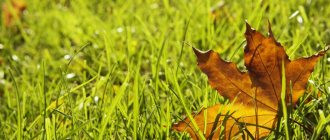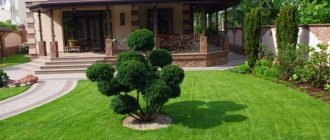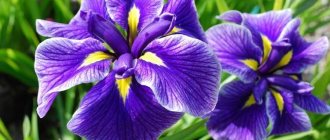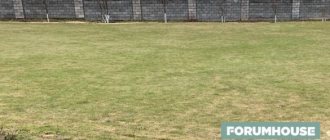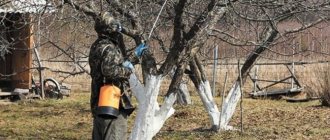Many people believe that to get a gorgeous, rich and lush lawn, it is enough to buy seed, plant it and ensure proper watering. In fact, it is almost impossible to grow a truly high-quality coating that will please the eye and tickle your heels without fertilizers.
Despite the fact that lawn grass is in fact a weed and grows well in “wild” conditions, the role of fertilizers in cultivation is underestimated, as can be seen at the end of the article.
Why does the lawn need to be fertilized?
Lawn grass is truly unpretentious to grow. Even the most inexperienced gardeners will be able to create a cozy landscape covering near their home in a couple of months of summer. Experts identify 3 important conditions for good growth of green grass:
- Sunlight and a sufficient amount of moisture - the covering must be watered daily on particularly dry days of summer, preventing its stems and rhizomes from drying out.
- Mowing with a lawn mower - this way the covering will be as dense as possible (if you cut off the top of any plant, the growth will expand in width).
- Fertilizer application - the lawn grass will receive the most saturated green color, good density and that cherished softness that many gardeners dream of when walking along a self-grown lawn.
What happens to soil that is watered frequently? Yes, the nutrients that are so necessary for the full growth and development of the lawn are more easily dissolved in it. But an excess of moisture also causes harm, dissolving and removing important potassium and magnesium from the soil, which leads to its depletion.
This is where those same fertilizers come to the rescue, containing the entire “bouquet” of elements necessary for green plants.
What happens to any grass that is cut periodically? That's right, its stem is injured, which increases the risk of drying out, as well as rotting when pathogenic flora gets inside. What will help strengthen the immune system and stimulate the growth of side shoots of the lawn?
Naturally, fertilizers, which are absolutely safe for human life and health, at the same time make it possible to have picnics on the royal lawn.
And the most important reason why fertilizers are necessary and important for the lawn is the rapid growth and development of grass, which leads to demineralization of the soil. The lawn really grows quickly, so it takes the maximum from the soil. All nutrients remain in the cut part.
Result: the soil is poor, the grass is scanty. Only by replenishing the deficiency of potassium, magnesium and phosphorus can we talk about the possibility of growing a lawn on the site. If you take everything all the time and don’t give anything back, a negative result will not take long to arrive.
How to feed your lawn in summer
In summer, lawn grass needs a lot of nutrients. Therefore, complex mineral fertilizers are considered the most popular at this time. Nitroammophoska and its derivatives are often used. Optimal time for fertilizing: late June - early July.
You need to feed the lawn immediately after mowing (no later than 1-2 days)
If the grass grows poorly and turns pale in the first months of summer, it should be fertilized with urea (urea) or ammonium sulfate. These compositions will provide plants with the necessary amount of nitrogen, stimulate their growth and improve color. Application rate is about 15-20 g per 1 sq.m.
Twice during the summer the lawn is fed with potassium salt. Application rate – 15-20 g per 1 sq.m. If the summer turns out to be rainy, the application rate can be increased, since potassium is actively washed out of the soil.
At the end of summer, you should reduce the application of nitrogen fertilizers and more actively feed the lawn with phosphorus and potassium additives. Most often, simple superphosphate (40-60 g per 1 sq.m.) and potassium sulfate (25-30 g per 1 sq.m.) are chosen.
Of the fertilizers that are always at hand, nettle ash is most often used. It contains about 30 macro- and microelements and up to 40% potassium. Dry freshly cut nettles for several days and then burn them. Collect the cooled ash and fill it with water in a ratio of 1:10. Water the lawn evenly with the resulting solution.
Signs of acute deficiency of nutrients in the soil
You can hear from gardeners that their soil is “quite fertile,” but in reality, none of them can boast of a luxurious lawn. No amount of frequent watering, shading and prayers can do what fertilizers with a trivial content of potassium and magnesium can do.
The following tips will help you recognize an acute lack of nutrients in the soil:
- yellow feathers on the grass;
- presence of bald spots on the coating;
- hardness and causticity of the lawn;
- color change from rich green to faded light green;
- long recovery after cutting with a lawn mower.
Lack of mineral nutrition reduces the protective powers of the grass, which leads to the development of viral and fungal diseases that quickly spread throughout the area. Therefore, it is important to feed the lawn in a timely manner and saturate it with the elements necessary to create a high-quality landscape covering.
Florovit
This manufacturer has proven itself to be an effective fertilizer for lawns in the fall. The product, packaged in 1, 3 or 8 kg, has a reduced nitrogen content and a high potassium content, thanks to which the lawn retains its aesthetic appearance until the coldest weather and survives the winter period safely. Fertilizer can also be applied in early spring, before the growing season begins, to provide the grass with the necessary nutrients before a long period of growth.
Florovit for lawns
For information on where to buy these fertilizers at low prices and with fast delivery, read the article “The best stores selling lawn fertilizers according to RuNet”
Kinds
Depending on the nature, fertilizers come in two types:
- Organic - consist of particles of rotted grass and manure, which mainly introduce nitrogen into the soil, which is necessary for the active growth of green mass. Organic matter contains phosphorus in smaller quantities, the lack of which will not allow the growth of a dense layer of lawn cover.
- Mineral – contains potassium, magnesium, calcium and phosphorus. Together, they give a good start to a young lawn and support its vegetation throughout the summer, also allowing it to safely survive winter with frosts.
The market for gardening products offers a wide selection of complex fertilizers, which in a certain ratio contain all the necessary substances for the growth and development of green mass.
All a gardener needs is to apply fertilizers at the time recommended by the manufacturer, water the soil generously and enjoy the result (and there will be a lot to be happy about, believe me).
As for the release form, lawn fertilizers come in liquid and dry (garnished) form.
In the first case, the concentrate must be diluted with water in the dosage recommended by the manufacturer and distributed evenly over the area. Granules are easier to scatter, and water during irrigation will dissolve them on its own without human intervention.
DIY lawn fertilizer
Do-it-yourself lawn fertilizer from nettles
To prepare our own fertilizer, we will use nettles. A prerequisite is the absence of seeds on it. Place about a kilogram of greens on the bottom of the container and fill with 6-8 liters of settled water.
Let it sit in the sun for 10 days, stirring daily. At the end of the fermentation process, the fertilizer is used: for irrigation - diluted with water 1:10; for spraying - 1:20.
When and which ones should be paid?
Any plant has phases of its growth and development cycle, as well as a state of rest. Knowing these nuances, you can properly and purposefully maintain your lawn, making it a source of pride.
Ammonium nitrate in spring
After a long winter, the main task of the gardener is to quickly bring the lawn out of hibernation. Ammonium nitrate comes to the rescue, which is a source of easily digestible nitrate nitrogen, the activation of which in the soil is possible even at +5℃.
Experts recommend doing the following:
- When the temperature at night is above +3℃, scatter saltpeter granules over the remaining snow cover on the lawn.
- After 3-4 days, when all the snow has melted, the fertilizer, having dissolved in the moist soil, will begin to work actively.
- After a week, you can begin to carefully clean the lawn of last year’s grass and insulation.
Applying the first fertilizers is advisable only when the weather does not predict night frosts, otherwise the grass will suffer stress, which it will have to cope with for a long time. Typically this period falls at the end of March-beginning of April. In snowy regions, the timing of the first application of fertilizer is shifted closer to the end of April.
What ammonium nitrate will do in early spring:
- activation of metabolic processes in the rhizome;
- strengthening the general immunity of the plant;
- increasing green mass.
While planting work has not yet begun on the site, the lawn will delight you with a good carpet, and the May holidays can already be celebrated on a bright and soft lawn.
Complex fertilizers in summer
Nitroammofoska and Urea are the most popular and “richest” lawn fertilizers, which contain all the necessary substances for active growth and development of the surface. But they have one caveat - rapid leaching, so they should be applied in smaller quantities, but often, about once a month for watering.
Experts recommend applying fertilizers in the summer at night during heavy watering. Doing this under the sun’s rays is dangerous, as it can additionally cause a burn of the green mass.
Potassium-phosphorus fertilizers in autumn
The main task of a gardener in the fall is to prepare the lawn for a successful winter. To do this, you need to eliminate nitrogen, which stimulates the growth of green mass, and switch to potassium and phosphorus, which strengthen the grass and its rhizomes.
The last application of fertilizer should be done in mid-September, when watering ends and natural precipitation replaces sprinklers.
It is not recommended to apply organic matter to the lawn, since during the process of decay it generates heat, which stimulates the active growth of green mass during the period of the first frost. This is fraught with freezing of large areas of the coating.
The best fertilizers for this period are:
- “Superphosphate” - contains a double phosphorus formula, which is fully absorbed by plant roots.
- Bone meal is used to powder the surface of the lawn, which provides reliable protection against pests and rot that occurs with increased rainfall in the fall.
- Monopotassium phosphate is a slow-release fertilizer that will work throughout the fall, providing good protection for the grass during periods of severe frost.
Some gardeners apply manure to the lawn once every 2-3 years. It protects against severe frosts, nourishes the rhizomes and has a beneficial effect on the condition of the lawn as a whole, but in the spring the gardener can expect trouble in the form of parasites, the larvae of which have successfully overwintered.
Do you fertilize your lawn with manure?
Not really
Modern principles of landscape management eliminate the need for such a measure due to the development of a mass of negative consequences, when the benefit is several times less than the harm caused.
What substances are needed to fertilize the lawn?
To feed the lawn flora, the following elements are needed:
- nitrogen - accelerates growth, makes color more saturated;
- phosphorus - helps accumulate nutrients, improves metabolic processes;
- potassium - normalizes electrolyte metabolism, improves resistance to negative environmental influences.
Nutrient deficiencies can be easily determined visually.
If there is a lack of nitrogen, the grass grows slowly and bald spots may occur. The leaves lose their rich tone and become faded. With insufficient amounts of phosphorus, plants become very fragile, greenery takes on a lilac hue. Calcium deficiency is determined by burns on the foliage.
An excess of nutrients, as well as a deficiency, can harm plants. Therefore, when applying fertilizing, it is important to follow the dosage.
Excessive amounts of nitrogen make the grass weak, causing it to lose resistance to infections and parasites. Plants quickly age and wither. Excess phosphorus prevents the supply of other nutrients, causing the grass to slow down. Too much calcium burns the root system, which can cause plants to die.
To normalize the level of useful elements, you need to water the lawn frequently (at least 2-3 times a day).
Excess nutrients can provoke active growth of more aggressive plants (ryegrass, bentgrass).
This will negatively affect the decorative effect.
How to apply to the soil?
The most important thing in this case is to choose the right concentration. Manufacturers usually indicate the product consumption per square meter of lawn area.
If you take more fertilizers, then there is a risk of getting the opposite effect in the form of burns of green mass and roots, the recovery of which will take several weeks. If there are few fertilizers, then you should not expect much benefit from them. It is the concentration of the fertilizer that determines its quality.
Next, the following sequence of actions is performed:
- The lawn is cleared of weeds and foreign debris.
- The lawn is watered abundantly at the rate of 100 liters per 100 m2.
- The fertilizer is diluted in water or scattered over the soil as evenly as possible. If the lawn area is large, then for convenience, an automatic fertilizer spreader is used.
- Apply the prepared composition to the soil in the evening, preferably after 20:00, when the sun has completely set.
- Set water sprayers at minimum settings throughout the night.
After a few days, you can already evaluate the first results in the form of an abundant increase in green mass and rich color of the entire coating.
Applying fertilizers to dry soil is strictly prohibited. This can cause not only the formation of burns on the grass, but also damage to the root system, which will lead to burnout of individual areas of the coating.
Lawn care
Regularly you need to remove weeds, water, cut, aerate and comb the lawn grass. Aeration provides oxygen access to the roots. This is done using aeration sandals or verticulators.
Video: Lawn aeration - secrets of professionals
It is necessary to water the lawn a few days in advance to soften the soil. Verticulate. If necessary - twice. The next day, grind the soil.
Combing is done using a fan rake . Old waste is removed, collected and transported for incineration.
The grass is cut once a week . In the spring, when the grass grows to 7–8 cm , the lawn mower should be set to a height of 5 cm and the tops should be cut off. Less is not recommended as the grass weakens. To make it easier to work with, the lawn grass is first straightened with a rake and then cut. It is not advisable to cut the area after rain - wet grass sticks to the blades. It is also dangerous to use electrical appliances in a damp environment.
Lawn grass should be watered 3 times a week in summer , once in spring and autumn . The soil should be moistened by 15 - 20 cm . In order for watering to be effective, it is recommended to first remove debris and remains of dry plants. The right time is morning or evening.
Weeds that detract from the appearance of your lawn must be removed with herbicides. You should choose drugs that act exclusively on weeds, but do not interfere with the growth of cultivated herbs:
- Lontrel-300;
- Lapis lazuli;
- Puma Super.
Folk remedies in the form of vinegar also act on lawn grass, so they should not be used.
Rules for proper use
To avoid unwanted problems associated with fertilizing your lawn soil, remember the following rules:
- Each fertilizer is appropriate at a specific time - in spring and in the first summer months, the emphasis is on building up green mass, and closer to autumn - on strengthening and dividing rhizomes.
- First, haircut, then fertilizer - this scheme will bring more results.
- Do not exceed the dosage recommended by the manufacturer.
- Do not use unrotted manure, which is used as the main source of nitrogen.
- Regulate watering and do not apply fertilizers to dry soil.
It is important to maintain a balance of nutrients in the soil so that the lawn grows in an even and continuous carpet. If bald spots occur, you need to inspect this area and take appropriate measures before one small spot turns into a deserted area.
Video: useful expert advice
In order to always have an emerald lawn that pleases the eye, you need to take care of it: water it, sow it if necessary, and fertilize it. Work on the lawn begins in early spring, and the appearance of the lawn in summer depends on how complete and correctly it is done.
- Author: Natalya Nekrasova
Philologist by training. I have been writing articles since 2015. Rate this article:
- 5
- 4
- 3
- 2
- 1
(0 votes, average: 0 out of 5)
Share with your friends!
The best comprehensive products
In order not to waste time and effort calculating the required volumes and quantities of potassium, magnesium, phosphorus and organic substances, fertilizer manufacturers offer complex options.
They are easy to use, safe and effective for lawns in a variety of soil types.
"Fertika lawn spring-autumn"
Granular fertilizer, which contains potassium, magnesium, phosphorus and various organic additives that increase the immunity of the grass and help it cope with adverse weather conditions.
Available in convenient packaging, enough for several seasons. Well kept.
Advantages:
- Prevents weed growth;
- Suppresses pathogenic flora, protecting the lawn from rot and powdery mildew;
- Normalizes metabolic processes in rhizomes;
- Well suited for the first feeding after wintering;
- Quickly dissolves in the soil and does not cause the accumulation of nitrates;
- Safe for humans.
Flaws:
- Not identified.
It is applied at the rate of 10 kg per 1 sq.m of lawn. The concentration can be reduced if the soil is soddy-podzolic.
"Nitrogen-phosphorus-potassium chamfer for lawns"
The product is ideal for summer lawn care. Suitable for both amateur lawns and professional lawns. Promotes active growth of green mass, preventing the formation of bald spots and color fading.
Advantages:
- The granules do not stick together;
- Low consumption;
- Active growth of greenery in 2-3 days;
- Does not have an unpleasant odor;
- Dissolves quickly in moist soil.
Flaws:
- Not identified.
The drug is especially recommended in those regions where the summers are quite cold and rainy.
"Bona Forte liquid complex fertilizer for lawns"
Liquid fertilizer in the form of a concentrate is easily diluted in water and used on any type of soil. It is activated instantly, nourishing and saturating the soil with a whole complex of micro and macroelements.
The composition contains natural phyto-stimulants, which in the shortest possible time will turn a shabby lawn into a luxurious green meadow. Magnesium makes the grass more juicy and lively, and vitamins give it an emerald color.
Advantages:
- Protects against parasites, aphids, fungal diseases;
- Quickly restores cut grass;
- Increases the thickness of the coating;
- One cap of concentrate is enough for 10 square meters of lawn.
Flaws:
- Difficulties with depositing.
Many gardeners needlessly refuse liquid fertilizers for lawns, complaining about the inconvenience of applying them. In fact, it is enough to divide the area into sectors or sections, pour water on it and then walk around with a sprinkler.
Fertika Lawn. Autumn
This type of complex mineral fertilizer for the lawn is designed for application in the autumn (from August to the end of September-October), because contains an increased amount of phosphorus and potassium necessary for the plant at this time (NPK 6:13:36). Provides the lawn with powerful growth of the root system and increased safety in winter. The method of application is similar to that described in the previous section; when laying a lawn, up to 10 kg of product per hundred square meters is also used, when feeding an existing one - 2-3 kg for the same area.
Products from the manufacturer Fertik could previously be found in the country in the form of fertilizers for the Kemira lawn. In fact, nothing has changed in terms of composition, and nutritional products are produced using the same equipment and by the same specialists. Changes in the name are associated only with the purchase of the parent Finnish enterprise of Kemira by another company.
Fertika Autumn
Questions and answers
How often can nitrogen fertilizers be applied in spring and summer?
Ammonium nitrate, which is the best product with easily digestible nitrogen, should be applied every 15-20 days after the snow melts. During the spring period this is usually 2-3 feedings. In summer, it is better not to use nitrogen in its pure form, but to saturate the soil with it as part of complex fertilizers. It is important to consider whether you added humus and compost, which also contains nitrogen, before winter.
Granular fertilizer did not bring the desired result, but only burned the grass. The concentrations are met, there is enough water, what could be the reason?
It is important to remember that the granules should not fall on the foliage, but directly on the ground. Mowing the lawn before applying fertilizer helps achieve this.
Is it possible to use mowed lawn grass as animal feed if fertilizing has been done previously?
Experts recommend mowing the grass after applying fertilizers after 2-3 weeks. During this time, minerals are absorbed in full, so this herb can be used for animals without fear for their health.
In conclusion, it is worth noting that lawn fertilizers are one of the important elements that allow you to grow a solid, thick and beautiful lawn. They should be added wisely and not in excess. It is important to adhere to the manufacturers' recommendations indicated on the packaging. Fertilizers must be dissolved in water, so the soil must be well watered.
Basic nutritional and strengthening elements for a green lawn
The main elements contained in any fertilizer for feeding grass are phosphorus, potassium and nitrogen. Other chemical elements, especially iron, can also be used in the complex, but basic fertilizers always contain one of the three named components as the main one in one proportion or another.
- Phosphorus. This element promotes the accumulation and exchange of nutrients, is responsible for strengthening the root system of the plant and the healthy formation of new sprouts or shoots. Phosphorus most often belongs to the group of so-called direct or double-acting superphosphates and is an indispensable fertilizer for feeding the lawn in spring and autumn.
- Potassium. Potassium-based fertilizers help normalize the water-salt balance of the soil, strengthen and harden plants, including lawn grass, making it more resistant to non-optimal temperatures and forming a stable barrier against various types of diseases and pests. The most popular potassium-based fertilizers are nitroammophoska, potassium chloride, potassium magnesium or simple potassium salt.
- Nitrogen. Another important element for feeding lawn grass, which contributes to the formation of a rich color and healthy shape of the plant, and also accelerates the growth of grass. Nitrogen is found in varying amounts in fertilizers such as ammonium sulfate, urea or sulfate nitrate. Nitrogen fertilizers should be applied for feeding only in spring or summer, as they promote rapid growth of shoots.
You can determine the need to apply fertilizers with one or another main element in the composition based on the condition of the lawn. If bald spots form, growth slows, or color fades, the grass is in dire need of nitrogen fertilizers. A lack of phosphorus is determined by the fragility and lethargy of the lawn; potassium is needed in case of discoloration or sunburn on young grass shoots.
